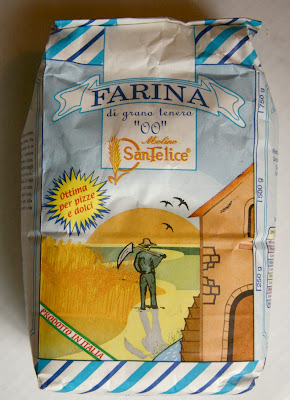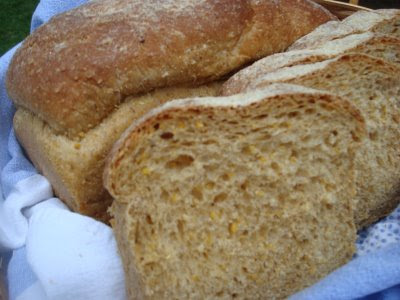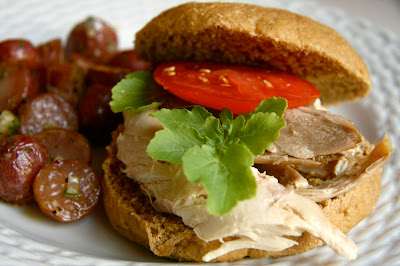 Learning to bake bread is one of the most satisfying things I've ever done. Every loaf is a new creation, and yet the very process of bread-baking is nearly as ancient as civilization itself. I've gathered recipes from sources old and new, from dusty books and from digital files. I've crafted loaves entirely with my own hands, and I've taken advantage of mixers and food processors. And in every case, the magic of the yeast, the ingredients, and the oven combine to create something warm, fragrant and inviting. Maybe some day I'll be blase, but for now I still experience a thrill, as a miracle observed, when I see the dough double.
Learning to bake bread is one of the most satisfying things I've ever done. Every loaf is a new creation, and yet the very process of bread-baking is nearly as ancient as civilization itself. I've gathered recipes from sources old and new, from dusty books and from digital files. I've crafted loaves entirely with my own hands, and I've taken advantage of mixers and food processors. And in every case, the magic of the yeast, the ingredients, and the oven combine to create something warm, fragrant and inviting. Maybe some day I'll be blase, but for now I still experience a thrill, as a miracle observed, when I see the dough double.There's also the social aspect: I've baked alone, I've had family members and friends stand beside me in my kitchen, and I've had virtual friends baking the same recipe at the same time and comparing notes on our computers via Twitter! And when the bread is baked? I love the smile when people bite into a fresh slice of bread, and I love posting pictures of my breads and viewing those of other bakers. There's a special connectedness in seeing that bakers all around the globe are baking around the same theme each month. Such is the special charm of Bread Baking Day - a monthly online event where bakers are invited to bake and share their bread.
The theme for this month's Bread Baking Day #20, hosted by Rachel of Tangerine's Kitchen, is "Multigrain Breads". While I've cooked many loaves in recent weeks that have more than one grain, the bread I really wanted to share this month is Peter Reinhart's Multigrain Struan, from his book, Whole Grain Breads: New Techniques, Extraordinary Flavor.
Reinhart has included a version of his struan bread in most of his bread books. The theory of the struan bread is that it is composed of what happens to be on hand, or in the current harvest. I feel quite blessed that my pantry is well-stocked, and I had all manner of delicious grains to choose for this bread. The version of struan in the Whole Grain Breads book is completely whole grain, and Reinhart's directions are quite detailed and thorough. Although you can find the recipe online, I'd advise getting the book if you are at all interested in baking with whole grains. The amount of information dispensed in the book is nothing short of astonishing.

n.o.e.'s notes:
- Reinhart advises that the bread is particularly good if a mixture of cooked and uncooked grains are in the dough, and he gives advice on cooking times and methods for the various grains.
- For my 6 oz of grain, I used:
1 oz steel cut oats (cooked 4 parts water to 1 part grain, as oatmeal)
1 oz barley (cooked 2.5 to 1)
1 oz quinoa (cooked 1 to 1)
3 oz Bob's 10 grain cereal (uncooked)
- I froze the extra barley and quinoa in 1 oz packets for future use.
- All of the flour in the bread is whole wheat flour. I used half white whole wheat and half regular whole wheat (both King Arthur) for the biga, starter, and final dough.
- My sweetener was agave nectar.
- In the proofing stage, the bread rose 1.5 inches above rim of 8.5 x 4.5 pan
- I did not use the steam option for baking. My bread was done after 50 minutes in the oven.
- We waited just over an hour before cutting.
the verdict:
When the bread was still slightly warm, we sliced into it and sampled it plain.
this was GOOD. We enjoyed the very subtle and complex flavors. The texture was moist and the taste just a touch sweet. The bread was versatile, too, and was delicious toasted with butter.
Note: I'm sending this bread to Yeastspotting, a weekly compendium of all things yeasty. Congratulations to Susan on her 1 year Yeastspotting anniversary!












































